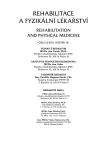Investigation of the Relationship between Urinary Incontinence and Coccyx Syndrome and Pelvic Floor, and with Pain Occurrence in Lumbar Region of Spine
Authors:
M. Hagovská
Authors‘ workplace:
V spolupráci s Kúpeľným zariadení Liptovské liečebné kúpele Lúčky, a. s.
; Klinika fyziatrie balneológie a liečebnej rehabilitácie LF UPJŠ a FN L. Pasteura, Košice
prednosta doc. MUDr. P. Takáč, Ph. D.
Published in:
Rehabil. fyz. Lék., 18, 2011, No. 4, pp. 183-187.
Category:
Original Papers
Overview
Objective of the paper:
Evaluation of the association of coccyx syndrome occurrence and pelvic floor with stress urinary incontinence and assessment of the low back pain occurrence related to urinary incontinence.
Methods used:
For the assessment of the pain in lumbar region of spine the Aberdeen low back pain scale has been used. For the assessment of quantification of leaked urine 1-hour pad test has been used. The patient file consisted of 66 women patients after abdominal and vaginal hysterectomy; 46 patients were incontinent and 20 without urine incontinence.
Results:
More frequent occurrence of coccyx syndrome and pelvic floor syndrome in incontinent women patients as opposed to patients without incontinence has been confirmed. A statistically significant correlation of urinary incontinence with the coccyx syndrome has not been confirmed. The urinary incontinence has been correlated with the low back pain symptoms. No statistically significant relation between the low back pain and urinary incontinence has been found. A higher occurrence of low back pain in incontinent women in contrast to continent women has been confirmed. In these two groups no statistically significant difference in lumbar region pain occurrence has been observed.
Conclusion:
It would be desirable to conduct the research of these phenomena also after further surgical interventions in the minor pelvis region, eventually to conduct the comparison with patients without any surgical intervention in the minor pelvis and with larger patient file.
Key words:
coccyx syndrome, pelvic floor syndrome, lumbar region pain (low back pain), stress urinary incontinence
Sources
1. BRUGGER, A.: Kurz FTVS UK. Praha, 11 - 18. 10. 1993
2. JANDA, V.: Přednáška. ILF, Praha, 1996.
3. KIJÁKOVÁ, K., TICHÝ, M.: Vliv některých svalů pánve na funkci křížokyčelních kloubů. Rehabilitácia, 1998, 3, s. 146-147.
4. KOLÁŘ, P.: Hluboký stabilizační systém. Přednáška. ÚVN, Praha, 1999.
5. LEWIT, K.: Některá zřetězení funkčních poruch ve světle koaktivačních svalových vzorců na základě vývojové neurologie. Rehabilitace a fyzikální lékařství, 1998, 4, s. 148-151.
6. LEWIT K.: Stabilizační systém bederní páteře a pánevní dno. Rehabilitace a fyzikální lékařství, 1999, 2, s. 46-48.
7. MAREK J. a.kol.: Syndrom kostrče a pánvového dna. Triton, Praha, 2000. ISBN 80 – 7254-638 – 4, s.45 - 47.
8. MAYNE, C. J., HILTON, P.: Short apd test: method and comparison with one - hour test. Neurourol. Urodyn., 1988, 7, 5, s. 443-445.
9. RUTA, D. A., GARRATT, A. M. et al.: Developing a valid and reliable measure of health outcome for patients with low back pain. Spine, 19, 1994, s. 1887-1896.
10. SILVERSTROPE, L., SKOGLUND.: A pathological erector spinae reflex - a new sign of mechanical pelvis dysfunction. J. Manual. Med., 4, 1989, 28 s.
11. SKALKA, P.: Úskalí rehabilitační léčby u močové inkontinence. Praktická urodynamika, Olomouc, 2001.
12. SKALKA, P.: Možnosti léčebné rehabilitace v léčbě močové inkontinence. Urologie pro praxi, 2002, 3, s. 94-100.
13. SMITH, M., HODGES, P. V., RUSSELL, A., COPPIETERS, M. W.: Incontinence and low back pain:inseparable conditions? Physiotherapy Research Update, 2007.
14. TICHÝ, M.: Anatomický podklad syndromu kostrče a pánevního dna. In: Marek, J.: Syndrom kostrče a pánevního dna. Triton, Praha, 2000, s. 17.
15. TICHÝ, M.: Dysfunkce kloubu II. Pánev, Praha, 2006, s. 72, 94-99.
Labels
Physiotherapist, university degree Rehabilitation Sports medicineArticle was published in
Rehabilitation & Physical Medicine

2011 Issue 4
- Hope Awakens with Early Diagnosis of Parkinson's Disease Based on Skin Odor
- Deep stimulation of the globus pallidus improved clinical symptoms in a patient with refractory parkinsonism and genetic mutation
Most read in this issue
- Central Coordination Disorder – Diagnosis for More than the Suckling Age
- The Conservative Therapy for Cervical Spine Instability in Patient with Rheumatoid Arthritis
- Respiratory Muscle Training in Patients with Breathing Disorders
- Investigation of the Relationship between Urinary Incontinence and Coccyx Syndrome and Pelvic Floor, and with Pain Occurrence in Lumbar Region of Spine
